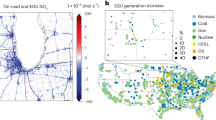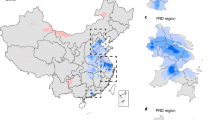Abstract
Ethanol-based vehicles are thought to generate less pollution than gasoline-based vehicles, because ethanol emissions contain lower concentrations of mono-nitrogen oxides than those from gasoline emissions. However, the predicted effect of various gasoline/ethanol blends on the concentration of atmospheric pollutants such as ozone varies between model and laboratory studies, including those that seek to simulate the same environmental conditions. Here, we report the consequences of a real-world shift in fuel use in the subtropical megacity of São Paulo, Brazil, brought on by large-scale fluctuations in the price of ethanol relative to gasoline between 2009 and 2011. We use highly spatially and temporally resolved observations of road traffic levels, meteorology and pollutant concentrations, together with a consumer demand model, to show that ambient ozone concentrations fell by about 20% as the share of bi-fuel vehicles burning gasoline rose from 14 to 76%. In contrast, nitric oxide and carbon monoxide concentrations increased. We caution that although gasoline use seems to lower ozone levels in the São Paulo metropolitan area relative to ethanol use, strategies to reduce ozone pollution require knowledge of the local chemistry and consideration of other pollutants, particularly fine particles.
This is a preview of subscription content, access via your institution
Access options
Subscribe to this journal
Receive 12 print issues and online access
$259.00 per year
only $21.58 per issue
Buy this article
- Purchase on Springer Link
- Instant access to full article PDF
Prices may be subject to local taxes which are calculated during checkout




Similar content being viewed by others
References
Martins, L. & Andrade, M. Ozone formation potentials of volatile organic compounds and ozone sensitivity to their emission in the megacity of São Paulo, Brazil. Water Air Soil Poll. 195, 201–213 (2008).
CETESB, Relatório Anual sobre a Qualidade do Ar no Estado de São Paulo [Annual Report on Air Quality in the State of São Paulo] (Companhia Ambiental do Estado de São Paulo, 2010).
La Rovere, E. L. Inventário de Emissões de Gases de Efeito Estufa do Município de São Paulo [Greenhouse Gas Emissions Inventory for the Municipality of São Paulo] (Centro de Estudos Integrados sobre Meio Ambiente e Mudanças Climáticas, Universidade Federal do Rio de Janeiro, 2005).
Fann, N. et al. Estimating the national public health burden associated with exposure to ambient PM2.5 and ozone. Risk Anal. 32, 81–95 (2012).
Gauderman, W. J. et al. Effect of exposure to traffic on lung development from 10 to 18 years of age: A cohort study. Lancet 369, 571–577 (2007).
Ponce, N. A., Hoggatt, K. J., Wilhelm, M. & Ritz, B. Preterm birth: The interaction of traffic-related air pollution with economic hardship in Los Angeles neighborhoods. Am. J. Epid. 162, 140–148 (2005).
Currie, J. & Walker, R. Traffic congestion and infant health: Evidence from E-ZPass. Am. Econ. J.-Appl. Econ. 3, 65–90 (2011).
Salvo, A. & Huse, C. Is arbitrage tying the price of ethanol to that of gasoline? Evidence from the uptake of flexible-fuel technology. Energy J. 32, 119–148 (2010).
Goldemberg, J. Ethanol for a sustainable energy future. Science 315, 808–810 (2007).
http://www.anp.gov.br/preco/prc/Resumo_Por_Municipio_Index.asp
Salvo, A. & Huse, C. Build it, but will they come? Evidence from consumer choice between gasoline and sugarcane ethanol. J. Environ. Econ. Manag. 251–279 (2013).
Al-Hasan, M. Effect of ethanol-unleaded gasoline blends on engine performance and exhaust emission. Energy Convers. Manag. 44, 1547–1561 (2003).
Graham, L. A., Belisle, S. L. & Baas, C-L. Emissions from light duty gasoline vehicles operating on low blend ethanol gasoline and E85. Atmos. Environ. 42, 4498–4516 (2008).
He, B-Q., Jian-Xin, W., Hao, J-M., Yan, X-G. & Xiao, J-H. A study on emission characteristics of an EFI engine with ethanol blended gasoline fuels. Atmos. Environ. 37, 949–957 (2003).
Hsieh, W-D., Chen, R-H., Wu, T-L. & Lin, T-H. Engine performance and pollutant emission of an SI engine using ethanol-gasoline blended fuels. Atmos. Environ. 36, 403–410 (2002).
Jia, L-W., Shen, M-Q., Wang, J. & Lin, M-Q. Influence of ethanol–gasoline blended fuel on emission characteristics from a four-stroke motorcycle engine. J. Haz. Mat. 123, 29–34 (2005).
Leong, S. T., Muttamara, S. & Laortanakul, P. Applicability of gasoline containing ethanol as Thailand’s alternative fuel to curb toxic VOC pollutants from automobile emission. Atmos. Environ. 36, 3495–3503 (2002).
Lynd, L. R. Overview and evaluation of fuel ethanol from cellulosic biomass: Technology, economics, the environment, and policy. Ann. Rev. Energy Environ. 21, 403–465 (1996).
Mulawa, P. A. et al. Effect of ambient temperature and E-10 fuel on primary exhaust particulate matter emissions from light-duty vehicles. Environ. Sci. Technol. 31, 1302–1307 (1997).
Poulopoulos, S. G., Samaras, D. P. & Philippopoulos, C. J. Regulated and unregulated emissions from an internal combustion engine operating on ethanol-containing fuels. Atmos. Environ. 35, 4399–4406 (2001).
Topgül, T., Yücesu, H. S., Çinar, C. & Koca, A. The effects of ethanol–unleaded gasoline blends and ignition timing on engine performance and exhaust emissions. Renew. Energy 31, 2534–2542 (2006).
Yoon, S. H., Ha, S. Y., Roh, H. G. & Lee, C. S. Effect of bioethanol as an alternative fuel on the emissions reduction characteristics and combustion stability in a spark ignition engine. J. Auto Engin. 223, 941–951 (2009).
Pereira, P. A. d. P., Santos, L. M. B., Sousa, E. T. & Andrade, J. B. d. Alcohol- and gasohol-fuels: a comparative chamber study of photochemical ozone formation. J. Braz. Chem. Soc. 15, 646–651 (2004).
Martins, L. D. & Andrade, M. F. Emission scenario assessment of gasohol reformulation proposals and ethanol use in the metropolitan area of São Paulo. Open Atmos. Sci. J. 2, 166–175 (2008).
Ginnebaugh, D. L., Liang, J. & Jacobson, M. Z. Examining the temperature dependence of ethanol (E85) versus gasoline emissions on air pollution with a largely-explicit chemical mechanism. Atmos. Environ. 44, 1192–1199 (2010).
Jacobson, M. Z. Effects of ethanol (E85 versus gasoline vehicles on cancer and mortality in the United States. Environ. Sci. Technol. 41, 4150–4157 (2007).
Beer, T. et al. The health impacts of ethanol blend petrol. Energies 4, 352–367 (2011).
Finlayson-Pitts, B. & Pitts, J. Chemistry of the Upper and Lower Atmosphere: Theory, Experiments, and Applications (Academic Press, 2000).
Seinfeld, J. H. & Pandis, S. N Atmospheric Chemistry and Physics: From Air Pollution to Climate Change (Wiley, 1998).
Jacob, D. J. Introduction to Atmospheric Chemistry (Princeton Univ. Press, 1999).
Anderson, L. G. Ethanol fuel use in Brazil: Air quality impacts. Energy Environ. Sci. 2, 1015–1037 (2009).
Romieu, I., Weitzenfeld, H. & Finkelman, J. Urban air pollution in Latin America and the Caribbean. J. Air Waste Manag. 41, 1166–1171 (1991).
US Senate Hearing 106-953 (US Government Printing Office, 2000).
US Senate Hearing 109-857 (Presentation by Mr Eduardo Pereira de Carvalho, president of UNICA, downloaded on November 17 2011 from website of Office of US Senator Richard G. Lugar) (US Government Printing Office, 2006).
Orlando, J. P., Alvim, D. S., Yamazaki, A., Corrêa, S. M. & Gatti, L. V. Ozone precursors for the São Paulo metropolitan area. Sci. Tot. Environ. 408, 1612–1620 (2010).
Cohen, R. C. et al. Quantitative constraints on the atmospheric chemistry of nitrogen oxides: An analysis along chemical coordinates. J. Geophys. Res.: Atmos. 105, 24283–24304 (2000).
Auffhammer, M. & Kellogg, R. Clearing the air? The effects of gasoline content regulation on air quality. Am. Econ. Rev. 101, 2687–2722 (2011).
Hughes, J. E., Knittel, C. R. & Sperling, D. Evidence of a shift in the short-run price elasticity of gasoline demand. Energy J. 29, 113–134 (2008).
Duranton, G. & Turner, M. A. The fundamental law of road congestion: Evidence from US cities. Am. Econ. Rev. 101, 2616–2652 (2011).
Vickrey, W. S. Congestion theory and transport investment. Am. Econ. Rev. 59, 251–260 (1969).
Holland, S. P., Hughes, J. E. & Knittel, C. R. Greenhouse gas reductions under low carbon fuel standards? Am. Econ. J.-Econ. Polic. 1, 106–146 (2009).
Bento, A., Kaffine, D., Roth, K. & Zaragoza-Watkins, M. The effects of regulation in the presence of multiple unpriced externalities: Evidence from the transportation sector. Am. Econ. J.-Econ. Polic. (in the press)
Goolsbee, A. & Petrin, A. The consumer gains from direct broadcast satellites and the competition with cable TV. Econometrica 72, 351–381 (2004).
Acknowledgements
We gratefully acknowledge numerous people from CETESB, INMET, CET and ANP for generously sharing their data; CBN Notícias for sharing their newscasts; and Raízen for sharing access to their fuelling stations. In particular, we thank W. Baptista, C. Costa, A. Dall’Antonia Jr, F. Henkes, M. Kuromoto, C. Lacava, D.G. Medeiros, R.C. Melo, R. dos Santos and T. P. Senaubar. We thank T. Aguirre for summarizing descriptive CETESB and CPTEC weather reports, M. Peterson for preparing a literature review as well as an initial written and graphical description of the pollutant and meteorological data, and S. Ritchey for listing the GPS coordinates of road segments. We thank S. Budanova, E. Lehman and C. Maalouf for research assistance, as well as J. Brito, M. Busse, J. He, E. Mansur and S. McRae for helpful comments. A.S. acknowledges support from the Initiative for Sustainability and Energy at Northwestern University (ISEN) and from the Dean’s Office at the Kellogg School of Management, Northwestern University. F.M.G. thanks the NSF Atmospheric and Geospace Science division for support under grant # NSF ATM-0533436 and gratefully acknowledges support from an Irving M. Klotz professorship in physical chemistry.
Author information
Authors and Affiliations
Contributions
A.S. conceived the research; A.S. and F.M.G. analysed the data and wrote the paper.
Corresponding author
Ethics declarations
Competing interests
The authors declare no competing financial interests.
Supplementary information
Supplementary Information
Supplementary Information (PDF 7395 kb)
Rights and permissions
About this article
Cite this article
Salvo, A., Geiger, F. Reduction in local ozone levels in urban São Paulo due to a shift from ethanol to gasoline use. Nature Geosci 7, 450–458 (2014). https://doi.org/10.1038/ngeo2144
Received:
Accepted:
Published:
Issue Date:
DOI: https://doi.org/10.1038/ngeo2144
This article is cited by
-
Impact of emission control strategies on air quality: a case study in Piracicaba, São Paulo—Brazil
International Journal of Environmental Science and Technology (2022)
-
Air pollution persistent exceedance events in the Brazilian metropolis of Sao Paulo and associated surface weather patterns
International Journal of Environmental Science and Technology (2022)
-
Wet deposition ethanol concentration at US atmospheric integrated research monitoring network (AIRMoN) sites
Journal of Atmospheric Chemistry (2021)
-
Rapidly increasing ethanol concentrations in rainwater and air
npj Climate and Atmospheric Science (2019)
-
Reduced ultrafine particle levels in São Paulo’s atmosphere during shifts from gasoline to ethanol use
Nature Communications (2017)



